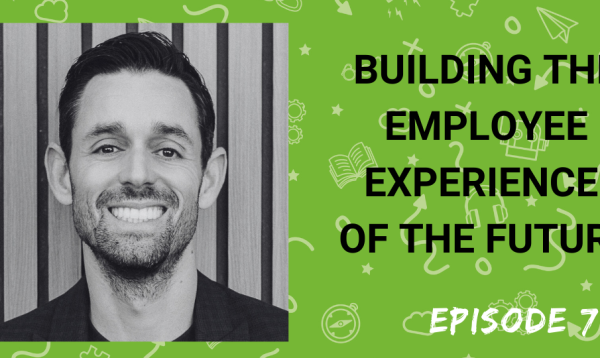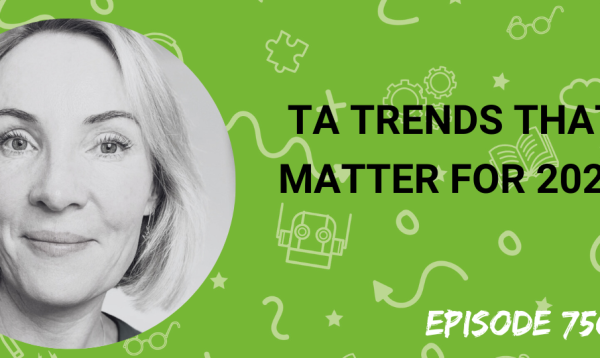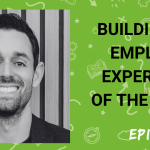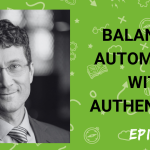Building diverse workforces via inclusive hiring is still a massive issue for many employers. But are organizations doing enough to fix the problem and what role should technology play in this?
My guest this week is Gareth Jones, CEO of Headstart. Gareth and his team are using data science to help employers change the way they think about people and talent in order to enable more inclusive recruiting processes.
In the interview, we discuss:
- Do employers really care about diversity?
- Why technology doesn’t fix broken recruitment processes
- Unconscious and conscious bias
- Why anonymized applications don’t solve the problem
- The importance of changing behaviours and attitudes
- Can technology be used in a smarter way, and what does the future hold?
Subscribe to this podcast in Apple Podcasts
Transcript:
Matt Alder [00:00:00]:
Support for this podcast is provided by Head Start. Hire diverse future leaders faster with Head Start. Create a fair and level playing field, hire candidates based on their potential and manage thousands of applications with ease. Organizations use Head Start’s applicant tracking platform with built in data science to hire more diverse candidates, automate the hiring process and reduce cost per hire by up to 55%. Find out more and get your free Radical Recruiter T shirt at Headstart IO RadicalRecruiter. That’s Headstart IO RadicalRecruiter.
Matt Alder [00:01:02]:
Hi everyone, this is Matt Alder. Welcome to episode 261 of the Recruiting Future podcast. Building diverse workforces via inclusive hiring is still a massive issue for many employers. But are organizations doing enough to fix the problem? And what role should technology play in this? My guest this week is Gareth Jones, CEO of Headstart. Gareth and his team are using data science to help employers change the way they think about people and talent in order to enable more inclusive recruiting processes. Hi Gareth and welcome to the podcast. An absolute pleasure to have you on the show. For people who don’t know you, could you just introduce yourself and tell us what you do?
Gareth Jones [00:01:50]:
Sure thing. Thanks. Well, thanks for having me. My name is Gareth Jones. I am currently the CEO of a company, I guess we’re probably a bit older than a startup now, but an organization called Head Start. And we are a, I guess a modern matching and screening and management system for recruitment specifically around early talent. And our sort of intent is to increase diversity and know, I guess increase inclusive hiring. So that’s who we are. So I effectively run that business. And we’re four years old and five years this year and then I guess in the scale up stage at this point.
Matt Alder [00:02:34]:
Fantastic. And I want to kind of dive in and talk more about diversity and the recruitment process as we, as we get into the conversation. But before we do though, we’ve known each other a really long time and I think it would be interesting for people to hear a bit about your story and how you got to do what you, what you do now.
Gareth Jones [00:02:50]:
Okay, sure. Yes. We have known each other for a while, haven’t we? We’re getting old, Matt. That’s the thing. We’re getting on a bit. So yeah, so I started my corporate life, my life in work over 30 years ago now, which sounds kind of a bit scary. It means I am, I am a relic, really. But I started in corporate HR and I did 10 years working in two global organizations. And as much as I enjoyed being in the people area, I found that I was disillusioned with it because I felt, you know, most organizations, including the ones I worked with, were sort of saying people are most greatest assets and they didn’t mean it really, they paid lip service to it. So I figured I ought to jump out of that to HR and get in, get a proper job. And when I was in a proper job I’d probably realize that people don’t really matter that much. And I was just, you know, dreaming. And so that’s what I did. I jumped into recruitment, into a search business actually for about 18 months and then that got me into technology, which was sort of a mid, late 90s by then and that technology was a startup and that’s why this thing got sucked into the dot com boom. So since that point and it was recruitment and HR technology Since the late 90s my career has been in and around people and people technology I guess so working with technology businesses. Having been a buyer on the buy side as a client, I was now on the sort of the vendor side, you know, the evil vendor side. But I sort of oscillated between working with startups and working in consultancies around HR people and technology. I did a couple of years actually in CRM, so I was out of the industry for that for a while and I ran a recruitment business hands on, ran that for a few years and did a bit of time in the actual recruitment industry as I guess as a recruiter but running the recruitment business and then being an ops director for the company, the larger recruitment company that took us on. And for the last 10 years I kind of stepped back into the startup arena, worked for myself for a couple of years and then in consultancy in recruitment again with chemistry. Most people will know if they know me and from chemistry built some technology for them, have carried on in that technology journey I guess by joining Head Start three years ago. So I’ve had a bit of a mixed bag.
Matt Alder [00:05:25]:
Yeah. And that’s why I asked you because I think you are, you are unique in some ways because you’ve seen, you’ve kind of seen this industry and you’ve seen talent attraction and recruitment from lots and lots of different angles and different directions sort of coming, coming, coming back to, coming back to, to, to this sort of issue of diversity. Now the, the benefits of a, of, of, of companies having a diverse, diverse workforce are quite well documented and quite well discussed and I would be very surprised if anyone listening to this podcast didn’t really understand what they were and what they, what they should be doing. But taking that into account, how much is it still a problem for employers to attract and retain more diverse workforces?
Gareth Jones [00:06:08]:
It’s interesting, you know, to use that word, problem. I think, I think it’s a problem they create for themselves, if I’m honest. It’s not like we have a shortage of diverse talent and it’s not like we have a shortage of talent anyway. You and I have debated that many, many times over the years. I think it’s a case of companies don’t set out, they have habits and habits take a long time to break. And we still have organizations largely run by white, stale, pale and male, you know, people who look like me, actually. And the recruiting practices over the last 30 years haven’t really changed in that respect. It’s become an agenda item and it’s become a very high profile agenda item in recent years. But we were talking about diverse hiring when I got into the workforce, only we talked about it in the, you know, we called it equal opportunities back then. But we haven’t made the landscape any more equal or created any more opportunities for the diverse groups. So it’s not so much a problem, it’s still a challenge for them because let’s face it, they can put a business together, grow a business, run a business and make in theory a healthy return for the shareholders and yet still report terrible diversity statistics internally. That happens. You know, if you look at the global diversity statistics, the number of women in leadership roles, the number of ethnic minorities in leadership roles, the number of ethnic minorities or other groups who fail to, you know, get promoted and, you know, etc, etc. If you look at those globally, we’re still terrible at it. And that sits aside all of the research that you’ve pointed out that shows that if you were to do it, if we were to be more inclusive and have a more diverse workforce, we would see better profits, we would see better, you know, better competition, we would, et cetera, et cetera. So I struggle with this because on the one hand you’ve got all of this evidence that, and it’s written by the great and the good, it’s from studies, you know, very good studies, Harvard, you know, everybody insead, they’re all saying this, they’re all publishing these papers and have them for years, Deloitte, Accenture, everybody. And yet the reality is the organizations are still ignoring it and yet they’re kind of saying, oh, we’re struggling with it. We can’t find the first talent. I just think it’s nonsense. It’s because they don’t want to. They don’t really care. Fundamentally, they don’t care enough. The leadership doesn’t care enough. It might sound a bit controversial. If it did, it would change it. And an example I used recently in a conference was if the finance director or the, the head of CRM in a global business came along and said, hey guys, there’s this new supply chain structure that’s been researched by Harvard and Insead and everybody else and they’ve got plenty of case studies to show this new supply chain infrastructure works, suits our business. And if we did this, we would be 20% more efficient and we would drive to 50% more revenue. You know, we should be doing this. The CEO and the FD would be all over it like a rash, but they’d be stupid not to do it. And yet you’ve got the similar kind of compelling evidence for inclusive hiring and we ignore it. And I can only assume that that’s ignorance or incompetence at the end of the day. Why wouldn’t you do it? And the really interesting thing is that we make a big deal about it. Yes, our workforce. We want to make diversity a big thing this year. We want to, you know, leverage talent. We don’t think we’re getting enough. We want to do. This is a big thing. On the CEOs I see it report day after day, CEOs concerned about the talent mix in their organization, CEOs concerned about the quality of talent in their separate functions, etcetera, Would do something about it. So I don’t think it’s a problem. I think it’s just a challenge of attitude, if I’m being honest.
Matt Alder [00:10:18]:
It’s a very big issue and I think we could discuss lots of different aspects of that. But if we were to sort of, if we zero in on the, on the recruitment process side of things, how do current recruitment processes contribute to that challenge?
Gareth Jones [00:10:33]:
That’s interesting because I think, you know, there’s definitely a role for technology to play, obviously. And I think there are two dimensions that are, that are worth talking about. One, the current recruitment process is generally poor and broken, I think because it hasn’t, again, it hasn’t changed much at all. We’ve thrown a lot of technology at it over the years. So, you know, post.com boom you were, you, you worked in the, you know, employer branding and advertising industry. The good old days of print advertising and how that shifted but ultimately all we did was put the job online, right? We put a job ad and took it out of a print magazine and stuck it online and encouraged a million people to apply for a job who’d never applied for a job before. So we push technology at it, but we haven’t re engineered the process, we haven’t really improved the process or the quality of the process. So we find ourselves with people who are trying to recruit. And by not, and I’m not talking about people who, there are some clearly, but most of the people who are recruiting aren’t trying to filter out diverse candidates. They’re not saying I’m going to discriminate against people. But it’s in their consciousness, right? It’s in their subconsciousness, it’s happening. Their unconscious biases exist. And that’s just with the recruiter. When each step it looks at a cv, it looks at an individual. Then you’ve got the hiring managers who have, you know, want to hire in their own image and all of those things. And I think that that process is broken and needs a complete rethink. And you know the obvious thing when it comes to technology, and you will have seen this and heard this and probably have vendors talking to you about it, but the obvious thing is to say, I know, let’s use technology to do, to make it, to make it better. And the default for that is let’s anonymize CVs, let’s remove photographs, let’s do all of these things that we can that remove. Let’s strip the identity away from this candidate who might be in a, in a minority group or disadvantaged in some way. You know what? To me, albeit I work in a technology business and I work in a technology business that serves this market, but that feels so dehumanizing to me and I really feel strongly that that might be the direction of travel of the product teams in a lot of the recruitment processes. But I don’t think it’s the answer. And it might be that we’re forced to put that kind of stuff into our product and we don’t at the moment. And I think the reason is for me, if I start and we start stripping names and pictures and any sort of identifiable material out of, out of CVs and applications, which I can see, I can understand it, I can understand that we want to try and level the playing field. All that’s doing is kicking the can down the road, right? We’re not changing behavior, we’re not changing issues and attitudes, right? At some point that Candidate’s going to come into the business or in the new world jump on a video call and meet somebody and those prejudices are going to come back. And so what we really need to do is change behavior and attitudes. We need recruiters and hiring managers. We need to highlight diversity in the recruitment process. We need to re engineer the process so that it makes it completely transparent. So that I actually have to sit there and consider I have a shortlist here that doesn’t have enough diverse candidates on it or I have a shortlist here that’s full of diversity. I need to talk my hiring manager through that. We both need to face our prejudice and our subconscious biases. That’s I think the approach that we should be taking. So it’s not necessarily straight into technology and technology is going to solve the problem. I think this is a human thing and the process is broken.
Matt Alder [00:14:31]:
I couldn’t agree with you more. And I think there’s a lot of talk about unconscious bias but, but actually, and you know, a lot of it, you’re kind of almost hinting at it and some of the things that you said, there’s a lot of conscious bias as well that can manifest itself in something as simple as well, because this person is, has, has this amount of experience that they’re, they, you know, they’re going to be too old for this job or because this person has worked in this industry, they couldn’t possibly work in our industry or they couldn’t possibly have skills that map across because we’ve never recruited anyone in the past who, who has done that. And we’ve not done that because we’re consciously biased against doing it. So I completely agree with you there. Obviously you’re also saying that the technology is not a silver bullet that solves this and people are looking at potentially some sort of quite crude ways of using technology as a solution. Are there there smart ways of using technology to help with this problem?
Gareth Jones [00:15:27]:
Yeah, I think there are. So I think it comes down to data, doesn’t it? To try and so, you know, some of the stuff that we’re looking at, we’re trying to look at. So what, you know, what data is there in this data society that we can use that’s relevant? How can we highlight something that’s not quite so obvious? So you know, clearly it’s with some elements of inclusive hiring it’s quite obvious, you know, origin of candidates and stuff like that. But some of the things that we’re looking at, for example are socially disadvantaged individuals who may or may not present themselves in a way that you find familiar or not, or that might, you know, engage your unconscious or indeed conscious biases. So people who, for example, so you might get two people who present to an employer as an early talent, you know, entry level employees, you’ve come from both, they both come from Oxford, let’s just say, right, if you’re still an employer who’s convinced that red brick universities produce the best talent, which they don’t, but rant over on that, but let’s just say you’ve got two to people who present themselves to your organisation and they both got a first class honours in economics or arts just to be included. And you know, what is the difference between those two people? It might be that one of them has come from a very typical middle class background in the uk. They maybe have been grown up in a family that has been together and is still together. They went to private school, possibly had the benefit of private education, which as we know gives you certain entry level credits to Russell Group universities. And therefore, I’m not going to say that take anything away from their intellectual capability or horsepower or the amount of work they’ve done to get to that point, but there might be somebody standing right next to them who also has a first class honours in economics or arts or something from Oxford, whose parents split up when they were eight, they became a parent carer at 14, they had to work two jobs as well as go to school and they had to put themselves through university. And they grew up in that environment they grew up in was a socially disadvantaged environment. That person has characteristics and traits that are invisible. And we can use data where it exists to surface that social disadvantage, because in that context that individual has outperformed their social norm, their social group. So that is a way of us using technology and data to be able to highlight the differences in individuals and character and therefore maybe give that person an opportunity that they wouldn’t have had previously. So it’s that kind of thing that we’re looking at to see, is there a way of highlighting some of the more invisible and perhaps some of the more difficult elements that people have faced as they’re trying to get themselves, lift themselves out of their current situation?
Matt Alder [00:18:48]:
You talked about things being invisible and then at the same time you talk about data. What do you mean by data in this context? What is it that you’re looking at that helps, that kind of helps tell that story?
Gareth Jones [00:19:02]:
So it’s, it’s a bunch of stuff. So there’s, there’s a bunch of data that comes from the individual. So you know, where, where were they brought up? Were they brought up in a single parent family or not? Were their parents together when they were 21? But all of these are, which goes back to some of the studies done in the sort of the late noughties around data science and big data and you know, predicting your personality from Facebook and predicting a whole, a bunch of other things based on, you know, I guess some, some indicators. But we would look at whether they were the first person to go to university in their family, for example, out of their, you know, previous their parents or grandparents, where they actually lived at different stages in their lives and whether their parents were together, etc. That sort of data. And then we would, we bring in other data, more publicly available data. So things like postcode data, social deprivation data by postcode, free school meals by postcode, et cetera, so that we can try and identify whether individuals have, I guess, lived in an area or had those unfortunate circumstances or fought through those circumstances in order to get where they are. So it’s a blend of, you know, individual data and publicly available data that we can kind of, you know, put our data science hats on and see if we can find any relationships or correlations between the two.
Matt Alder [00:20:35]:
What kind of companies are embracing this kind of approach and what are they seeing in terms of results?
Gareth Jones [00:20:41]:
It tends to, well, you know, I mean, obviously the clients that we work with, a large enterprise, so and actually, in fact the larger consultancies are showing them, I guess the most interest in it. They’re very interested in social deprivation and whether as part of their inclusive hiring they can be more inclusive in those things to recognize that because I guess it’s a bit of a cliche, isn’t it, but looking for certain behaviors, determination, getting, cutting through and you can sort of see some of those behaviors in people that have come up in difficult circumstances. So I think for sure, businesses, the larger organizations and the consultancies particularly are definitely trying to make themselves or recognize the diversity problem because they have to deliver excellence to clients. Right? They’re the guys that are telling the clients, the enterprise organisations, how they should be building people, excellence and talented workforces. So I think those are the guys that are the most interested in this and they seem to be more have more empathy towards understanding whether people have had challenging upbringings as their future leaders. And I think that’s part of it. I think the consultancies think a little bit more strategically. So they do see their entry level hiring as their future leaders. Right. Whereas I’m not sure. A lot of other companies do. They see it as they’re just their entry level hiring the graduates, the cheaper labor sometimes, let’s be honest. So I think they’re seeing it as a strategic imperative for them and they’re genuinely interested. And in terms of benefits, I think I’ve worked on a number of projects in Head Start and in others historically that have broken limited beliefs and forced people to look through different lenses. So very simply, where they thought they would be fishing for talent and looking for talent in a place where they thought the best resided in the world of early talent in the top universities. Top universities and top grades equals the best employees and therefore the best results for us as a business. And that’s been proven to be completely wrong. So now these organizations are discovering that actually the highest performing people in their organisations can come from any background. Actually not even necessarily a graduate. If we’re talking early talent, which is obviously the space that I’m in right now, and I’ve seen that, both at Head Start and I’ve seen it at the time, particularly when I was working at Chemistry too, that it surfaces people who are very capable and very credible and it blows away their perception of where they should be looking for that talent.
Matt Alder [00:23:52]:
As a final question, we’re recording this interview mid April 2020. We’re in the middle of the global pandemic crisis and it’s becoming clear that talent acquisition is going change coming out of this. Now how it’s going to change is less clear. But lots of employers are thinking about what does the future look like and what does their future strategy look like. Do you think that what’s going on at the moment is a catalyst for changing the way that recruitment processes work? What do you think?
Gareth Jones [00:24:31]:
I don’t think actually it will change that much in the grand scheme of things. Sure, if the recession, if this rolls out, as I guess we, it will, although we’re not sure how it’s going to pan out, but let’s say it looks like a recession, only worse, then we will see recruitment will go down significantly. The recruitment industry will probably, you know, take a panning and recruitment activity will probably stop or go down to very small levels. And yes, some organizations will try and re engineer, take that opportunity for change. So yes, well, while we’re shrinking the recruitment, let’s make it more efficient so we don’t have to hire more recruiters next time. Let’s put some technology in. So it’s a good time to make some changes, there’s no doubt about that. And we will see that happen fundamentally. Would it change our approach to recruiting? No, I don’t think it will. Because when we emerge, the other side, companies will still largely be the same kind of companies. Recruitment is a supply chain. It will only change if the demand in the organization, the way the organization runs itself, the way its way of working changes. Also, just like in the 80s and 90s, we changed manufacturing. Typical old factory. We had stores on site, lots of inventory kept, and yet we shifted manufacturing to be far more efficient. We got rid of stores, we got rid of our inventory, we stopped paying for inventory. And the supply chain to a factory changed massively. And people were. Suppliers were delivering parts every hour to that particular line, and the company only paid for them when they took them off the shelf and put them on the car, for example. That made. It was a fundamental shift in the way the supply chain of goods into a factory because we fundamentally changed the way we work. And that’s going to be the same with people and people supply. In business, the problem to be solved is to get the right person in the right job at the right time, every time as a CEO of a business, no matter how big it is. And actually, to do that, I need to understand my internal talent so much better. We’ve become obsessed with hiring, obsessed with finding the best talent and fighting this war for talent that actually we’ve forgotten about the talent that we have internally. So we need to get way more sophisticated and understand the people that we have in business and then change the way we allow them to work, embrace technology, allow people to work more flexibly, treat them like adults, fundamentally allow them to challenge the processes inside a business before that will change. So I don’t think we’re going to see a massive fundamental shift in the way we recruit and a different attitude from recruiters and a different attitude from the leaders at all. I think if we recover and as and when we recover from the recession, we will see a return to the way we recruited before. I don’t see at the moment any incentive to do. To do any change. And of course, unless we fundamentally change the way we work, there won’t be a mandate to do anything different, except maybe try and make it more efficient. So, no, I don’t think there’s going to be sweeping changes across the industry and sweeping improvements in the way we work as a result of it. No.
Matt Alder [00:27:39]:
Gareth, thank you very much for joining me.
Gareth Jones [00:27:41]:
No, you’re welcome. Matt, thank you very much for having me on. It’s been a pleasure.
Matt Alder [00:27:44]:
My thanks to Gareth Jones. You can subscribe to this podcast in Apple Podcasts or via your podcasting app of choice. Please also follow us on Instagram. You can find the show there by searching for recruiting Future. You can also listen and subscribe to the show on Spotify. You can find all the past episodes@www.rfpodcast.com on that site. You can subscribe to the mailing list and find out more about Working with me. Thanks very much for listening. I’ll be back next time and I hope you’ll join.









